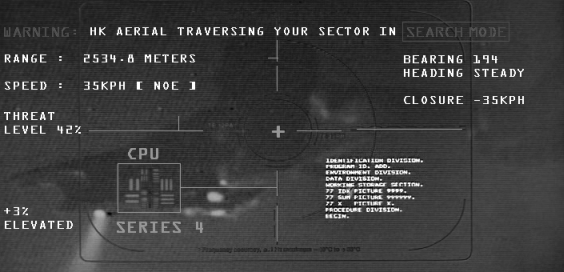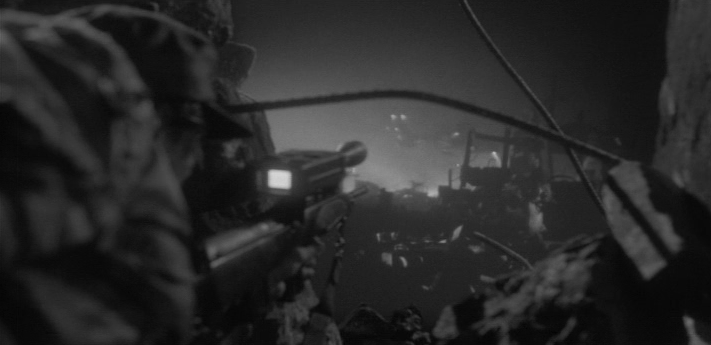
FLEXY SIGHT
"He threw a
glance up into the blasted spires of the collapsed building and saw a dark shape
moving against the night sky; the H-K's turret.
Its searchlights swept down through the ruins. Reese checked the
"Pulse Remaining" level on his
Westinghouse
M-25. The rifle had only one plasma pulse left. Take a shot.
Blind the son of a bitch. Resse aimed up at its
eyes, the infrared lenses of the gun mount.
Reese flipped up the
rifle's flexy sight -Oh, shit, faster, faster- stared
into the CRT scope- Move, Goddamnit, move- and
squeezed off a burst of high-energy plasma.
The H-K's ultra-high sensitive lens exploded into a shower of
glass and melted microchips.
Then the gleaming
black monster fired.
Reese and Ferro dove
out of the building as the H-K vaporized what was left of it. But Reese
had blinded it on one side. Good. And now I'm gonna
kill you, he thought."
-Frakes and Wisher,
THE
TERMINATOR
MODEL 12 ADVANCED
BATTLEFIELD SIGHT SYSTEM- CRT SCOPE / aka "Flexy
Sight"
MANUFACTURER:
None. Limited quantity unit, hand-made by Sci /
Comp and Tech / Com core. Production requires twenty different
parts salvaged or stolen from several SKYNET source machines.
Reproduction of most parts beyond technical or industrial capacity of mankind
at this time. Kit-bashed unit, assembled by hand
under controlled construction conditions.
TYPE:
Integrated digital combat data assistant (CDA), tactical target
acquisition
unit produced from scavenged parts taken from destroyed Machines or
raided from
depot supplies.
CONSTRUCTION:
Contemporary solid state microprocessor and motherboard, mated to a hardened
carbon fiber / monofiber case rated as shock proof
and environmentally sealed. Redundant sensors and arrays integrated into
main array. Standard rail type attachment point for use
on most standard human weapons. Can be removed and mounted on
small tripod for use by itself. Includes cable port for the use of a
standard shielded fiber optic data cable between the unit and any other
hardware equipped with a hardwire port. Component parts are as follows:
1
quantity of Series 5 Mod 3 Type 4A Digital Processor Array
1
quantity of Series 3 Mod 3 Type B2 Digital
Thermalgrapher
1
quantity of Series 4 Mod 2 Type Cx4 Digital Comparative Scan Processor
1
quantity of Series 4 Mod 2 Type Cx2 Digital HRIR High Resolution Infra-Red
Array
1
quantity of Series 9 Mod 4 Type AA23 active IR emitter array
1
quantity of Series 3 Mod 3 Type B1 cryogenic coolant assembly
1
quantity of Series 4 Mod 1 Type C1 coolant pump rated to level 3 specs
1
quantity of Series A Mod 1 Type X5 variable spectrum pulse laser emitter
1
quantity of Model 7 Series 3 400gb flash memory storage cache
2
quantity of Type 4 Level 6A video memory sticks (25gb memory ea)
1
quantity of Level 3, OS 4.0A, Rev 3G operating software with SIMA standard
integrated modular assumption
1
quantity of Type 3i HDCMSA crystal matrix storage array
1
quantity of Type 3 Mod 5 Series 3x high resolution plasma display unit (5cm x
4cm, 4.5cm x 3.8cm viewing area)
1
quantity Series 2 Model 3 High Speed data bus, 5gb cache
1
quantity Type 4D mainboard, modified with redundant
processor array inlay reworked to OS 4.0A specs
2
high density shielded (Category 8D) twist-lock weather sealed data ports for
use with hard cables
2
high density shielded (Category 8D) twist lock weather sealed data cables (1.5
meter length) for field use (stored in protective nylon pouch and plastic wrap)
ASSEMBLY TIME: 6
hours labor using specialized custom built assembly tools, a full metric set, a
Class IV laptop running OS 4.0 Rev 3G, a copy of Martin's GUI, a soldering gun,
one tube thermocouple paste, one tube molecular adhesive paste, custom built
assembly case, custom built mounting brackets, one M-25A1 pulse rifle to
synchronize unit to onboard electronics and the patience of Job.
OPERATION:
Passive 30,000 multiple low light amplification with
integrated 5 second digital cached overload filter. Passive high
resolution wide band infra-red receiver with user selected active
illuminator. Thermal and Electromagnetic sensor coaxial to main
array. Frequency modulated pulsed laser with variable spectrum
array. Microprocessor controlled digital and liquid optic image
enhancement offering up to 40x zoom in all optic modes. Digital video
capture mode at 200 frames per second, 10gb video
buffered memory, 30 gigahertz cryo-cooled
microprocessor. 400gb flash drive for onboard
storage or can communicate at 2gb per second secure laser in laser to laser
mode.
WEIGHT:
Approximately (+ / -) 1.35kg standard, varies on an individual unit
basis since
each unit is hand crafted and assembled from available salvaged parts
on a
limited production basis. Substitution of some parts for older or
newer
series may increase or decrease specified weight. Deletion of
some
component parts may also decrease weight in the expediency of
assembling the
unit.
Total loaded weight: 1.8kg
DIMENSIONS:
Length overall, 25.4 centimeters
POWER SOURCE: Rechargeable Type
3i high density crystal storage matrix, optimized power conservation
subroutines, 30 hour duration at maximum use. Slot for second battery
pack which will increase weight of unit by another 0.45kg, bringing total
weight of unit to 2.25kg and total field operational use to 60 hours duration.
HISTORY:
SKYNET enjoyed a
tremendous technological advantage over the human race, so much so that in the
beginning, it was felt that the AI's lead would be insurmountable and it would
have been, if humans had relied on their own technological development.
Humanity was fighting an enemy it could not out research, an enemy which held
the technological field and as such, humanity was often left with doing what
they did best; adapt and overcome.
The Model 12 was just
such a compromise. As SKYNET's technology was
studied by the humans, the technological head start the AI enjoyed became all
too readily apparent. The huge automated factories under machine control
were operating with technology that seemed borderline magic. Mankind
would never be able to get a technological advantage over its enemy, but it could
adapt by salvaging and studying SKYNET's technology,
trying to reverse engineer it or failing that, to integrate it into their own
order of battle and use SKYNET's technology against
it. The Model 12 was just such a breakthrough.
The Machines that hunted
humans were equipped with very advanced sensor systems that scanned the visual
spectrum from the infra-red, through visible light and into the ultra-violet
range. The liquid crystals were capable of enhancing images at up to 40x
zoom magnification while powerful processors filled in the rough spots to form
a composite picture with 97% accuracy. Laser range finders in both
infra-red and visible spectrum gave precise distance readings and with the
pulsed array, constant feedback and adjustment. The thermal resolution of
the standard optics employed by SKYNET's hunter
killers could detect heat variances of + / - one degree, giving a composite
picture and could read a residual thermal variance up to 30 minutes after it
was made.
This compact yet
powerful vision enhancement and tactical data assimilation system offered
thirty power digital telescopic zoom with microprocessor controlled high
definition display as well as low-light, infra-red, and thermal imaging.
A modulated Superconudyne variable spectrum targeting
laser gave accurate range readings as well as acted as both a laser aiming
device and a target painting designator. The variable design allowed the
user to switch the laser either from visible spectrum to infra-red. it could also be linked to the soldier's personal tactical
computer to send and receive data pulsed information on targets. A
micro-pulse scanner built into the battlefield sight system could also scan a
target to collect data. The collection and dissemination of data between
soldiers was a key element of the USPLW21, allowing coded and secure sharing of
all tactical information.
The small GUI display
was touch sensitive but most soldiers preferred to simply plug their sights
into their integrated helmet optics by using a pair of (provided) Category 8
shielded cables, thus projecting the information gained from the sight directly
onto the HUD display of their combat electronics suite. The information could be shared as well
by allowing another soldier to plug a patch cable into the sight and feed off
of the data stream to their helmet HUD suite. The male and female cable ends allowed
one Category 8 cable to be connected to another Category 8 cable to form a 3
meter long (1.5 meter x2) data cable in the field. Soldiers sharing information from a flexy sight could often link cables together to form long
daisy chains and scatter their thermal images among the ruins, separated by the
cables and thus lowering their threat projection for any machines in the area
which might be in search mode.

CRT image from flexy sight in passive mode.

Pictured above- A human soldier in the Resistance group using a TI-M12 ABSS system atop her M25A1 phased plasma rifle to carefully observe and passively gather critical tactical information on a patrolling A4 Mark VII Aerial HK unit traversing the sector in search mode. This information is then instantly assessed by her personal tactical computer and is then relayed to other units via encoded infra-red laser com pulse. The data will eventually get back to command group via a network of line of sight transmitters where it will be analyzed by the tacticians assigned to the combat group. The humans were careful to disguise and camouflage their tactical transmitters but SKYNET managed to find them eventually, requiring the humans to constantly replace or upgrade their network system among the ruins.
_______________________________